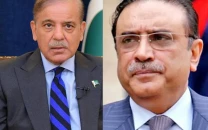PTI-led govt's debt surges to Rs27.6tr by Feb-end
Increase driven by low tax revenue, high expenditure and currency depreciation

Representational image. PHOTO: REUTERS
From July through February 2018-19, the government on an average added Rs14 billion a day to its debt, which included almost six and a half months of Pakistan Tehreek-e-Insaf (PTI) government, according to the State Bank of Pakistan's (SBP) statistics.
There was a net addition of Rs3.4 trillion from July to February, which was higher by 13.9% when compared with June 2018 statistics.
The accumulation of debt is the direct result of the gap between expenditures and revenues, which is widening due to the inelasticity in debt servicing and defence needs and the Federal Board of Revenue's (FBR) failure to enhance revenue collection.
In first nine months of the current fiscal year, the FBR suffered a shortfall of Rs318 billion in revenue collection.
The FBR's tax collection grew at a pace of 2.4% in the nine months, which was even lower than the nominal gross domestic product (GDP) growth of nearly 12%.
Government estimates show that nearly 69% of the total budget will go to debt servicing and defence purposes, which is higher than net revenues of the federal government. Due to this trend, the International Monetary Fund has proposed to target primary budget balance, which means that current expenditures, excluding debt servicing, should not be more than the revenues.
The overall increase in the central government debt seems not to be in line with the budget deficit requirements due to currency depreciation. An increase in interest rate by the State Bank of Pakistan (SBP) has also added at least Rs500 billion to the cost of debt servicing.
"The cost of debt servicing in the current fiscal year will be over Rs2 trillion after the recent hike in interest rate," said Finance Minister Asad Umar on Tuesday during an interaction with journalists.
The minister said there were no chances of a sharp reduction in debt as a percentage of gross domestic product (GDP) and it would gradually come down. Over the next five years, the debt would still remain above the statutory limit of 60% of GDP, he said.
Pakistan's debt capacity weakening, NA told
The central bank raised the key interest rate by another 50 basis points to 10.75% last week despite a decline in core inflation for the first time in 13 months. This puts a question mark over the SBP's strategy.
The external debt of the central government increased 18.42% to Rs9.23 trillion in first eight months of the current fiscal year. There was a net increase of Rs1.44 trillion in the external debt, largely due to currency depreciation.
In June 2018, the value of a dollar was equal to Rs121.54, which reached Rs139.055 by the end of February, according to the central bank. Since then, the rupee has further shed its value and was traded at Rs141.20 in the inter-bank market on Friday.
Pakistan’s debt and liabilities soar to Rs33tr
Umar said on Friday that the IMF had not placed any demand for rupee depreciation rather it had asked Pakistan to introduce a new exchange rate regime. He dispelled market speculation that the rupee would further shed its value.
The Rs9.23-trillion external debt does not include loans of $9.2 billion obtained from China, Saudi Arabia and the United Arab Emirates. Those loans are the responsibility of the central bank.
The ballooning public debt remains a concern due to the previous government's inability to attract non-debt creating inflows and enhance tax revenues. The PTI government is also struggling to enhance exports despite around 34% depreciation of the rupee since December 2017.
The most worrisome aspect was the continued growth in the short-term domestic debt, which exposed the government to refinancing and interest rate risks. The federal government's total domestic debt increased to Rs18.34 trillion, an addition of Rs1.92 trillion or 11.7% in eight months of the current fiscal year.
The share of short-term public debt slightly decreased to 57.4% or Rs10.53 trillion by the end of February. In June last year, the short-term domestic debt stood at 54.1% or Rs8.9 trillion. The short-term debt grew Rs1.7 trillion or 18.6% in eight months.
In the first eight months of the current fiscal year, the federal government's debt acquired through Market Treasury Bills (MTBs) from commercial banks massively decreased after it shifted financing to the central bank. The government's total borrowing through MTBs decreased Rs1.7 trillion to Rs3.6 trillion. The MTBs issued to borrow from the central bank rose to Rs6.9 trillion, a net addition of Rs3.3 trillion or 92.9% from July through February.
The retirement of the central bank debt may become one of the sticky points between Pakistan and the IMF.
The long-term debt, which was earlier shrinking, also went up 3.7% to Rs7.8 trillion. The debt obtained through prize bonds increased 11% to Rs945 billion.
Published in The Express Tribune, April 6th, 2019.
Like Business on Facebook, follow @TribuneBiz on Twitter to stay informed and join in the conversation.



















COMMENTS
Comments are moderated and generally will be posted if they are on-topic and not abusive.
For more information, please see our Comments FAQ